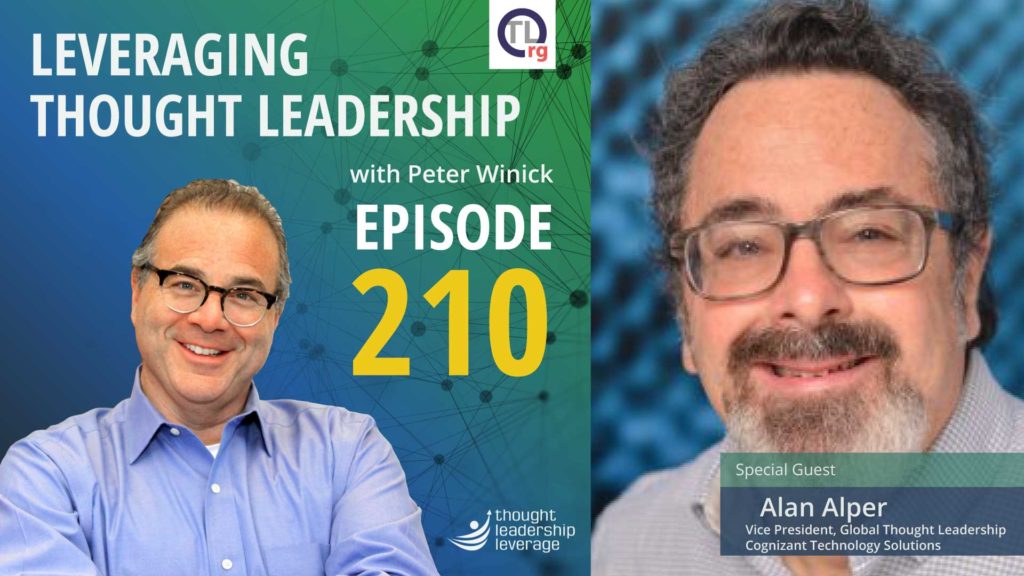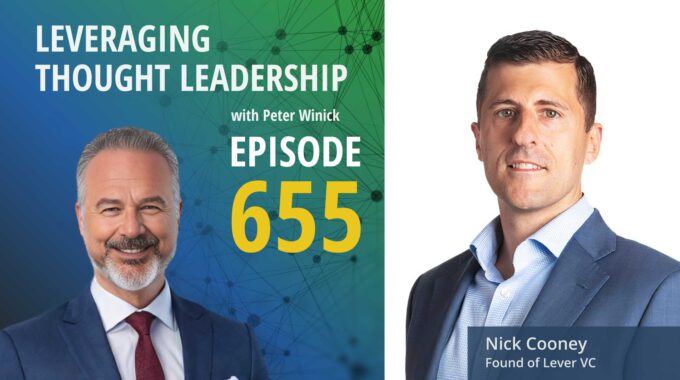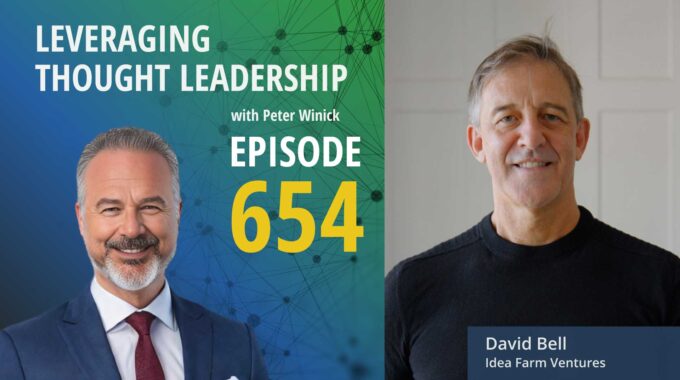Where Human Ingenuity Meets Machine Intelligence AI is transforming thought leadership—but not by replacing humans…
Defining Organizational Thought Leadership | Alan Alper | 210

What is Organizational Thought Leadership, and How Is Content Marketing Evolving?
An interview with Alan Alper about thought leadership strategy and defining organizational thought leadership, and how thought leadership success is measured in organizational thought leadership forms.
We interviewed Alan Alper, V.P. of corporate marketing and global thought leadership programs at Cognizant Technology Solutions, which is a global I.T. consulting and business services company. Alan’s work with organizational thought leadership is groundbreaking, and helping to forge new standards for content marketing in major organizations worldwide.
Three Key Takeaways from the Interview:
- What is organizational thought leadership?
- How can organizational thought leadership cause innovation and evolution of content marketing?
- How do you measure the ROI of thought leadership within an organization?
Join the Organizational Thought Leadership Newsletter to learn more about expanding thought leadership within your organization! This monthly newsletter is full of practical information, advice, and ideas to help you reach your organization’s thought leadership goals.
And if you need help scaling organizational thought leadership, contact Thought Leadership Leverage!
Transcript:
Peter Hey, welcome, welcome, welcome. This is Peter Winick, I’m the founder and CEO of Thought Leadership Leverage, and you’re joining us on the podcast today, which is Leveraging Thought Leadership. Today is one of our series that we’re talking to, organizational thought leadership, which we define an organizational thought leaders, which we define as individuals that are working in organizations or corporations that are practitioners of thought leadership. So today I have as my guest, Alan Alper, he is the V.P. of corporate marketing and global thought leadership programs at Cognizant Technology Solutions, which is a global I.T. consulting and business services company. He’s got a focus on developing and disseminating thought leadership content ranging from longform to short form, all sorts of video ET. And he is deep in thought leadership, deep in the corporate world. So welcome aboard.
Alan Alper Thank you. Thanks for having me.
Peter My pleasure. So first to me to ask you the trick question that I have fun asking everybody that’s on the organizational thought leadership side is how do you define thought leadership?
Alan Alper Yeah. You know, it’s a really good question. And, you know, you ask 10 people at Congress and you probably get 20 answers. But what I try to do is I look at it as something that really distinguishes our best and brightest, how we are working hard and informed about what our clients challenges are and how we have a proven track record of solving them. And yet we able to really show how we think through and act through it so that at the end, without saying it, we can be perceived as a partner of choice in almost any area that we engage.
Peter Excellent. So let me ask you then. I mean, there’s lots of things that you can be curating, creating, developing, deploying, et cetera. So some people get overwhelmed. How do you make the decisions around the areas to focus on with regard to thought leadership as it relates to aligning to the business metrics?
Alan Alper There a really good question, because there’s a lot of material that comes in over the transom, unsolicited thought leadership. Sometimes I put into the category of identity, thought leadership thinks they’re really smart and they’ve got an interesting idea and it makes sense among their elite people in the organization or their clients or their industry. Yet it doesn’t really resonate for the rest of us because it’s something that they’re so caught up on that it’s not really clearly communicated. So we look at it, we say, OK, this is an idea that we can own. This is something we want to be associated with. Is it something that helps us move the needle? If not, I very politely say, look, you know, great idea, but maybe this is a LinkedIn post that you can put on your personal handle. What we try to do is look at where do we want to differentiate and where do we want to excel and be perceived as a leader in a thong or otherwise. And, you know, the whole industry of business is moving to a digital landscape in any way we can be associated with the latest and greatest thinking on the topic. We’re all for so we have what, our call for digital battlegrounds. We want to we want to excel at. And if not, win in the marketplace and start with A.I. and data, cloud as the infrastructure, IOT as a means for obtaining and better managing the data that you’re collecting at the networks edge. And what we call software engineering, which is kind of the modern approach to building new cloud native applications or modernizing existing legacy systems so they can work in the digital age. If the idea fits there, if we have a differentiated point of view, if we have evidence to support our view, if we have examples that show how we work, that it’s not all just, you know, a blue sky thinking. Right. Right. I’m more than willing to sit down and work with our subject matter experts and get something produced.
Peter Got it. So your role is more. You’re not the individual task at Cognizant, which is a massive company to be our official thought leader. Right. Most of, most of what you’re doing is you’re adding to the conversation, but you’re also extracting the thought leadership from the masses and the curation of it.
Alan Alper It’s a good point because I mean, I’ve been around longer than the commercial PC. Yeah, I’ve seen a lot of these cycles before. I can, you know, using the sniff test, I can see what’s real and what’s Memorex. What’s about leadership and what’s BS? Yeah. And I do apply that filter to making sure that only the best and brightest ideas get through. Look, I don’t like to be a gatekeeper in some cases as an advisory led company, a lot of our folks are bonus on their thought leadership. So, I don’t want to get between somebody in their bonus at the same time protect the integrity of the company. They were taken of the company. So, we’re not just publishing materials. Yep. The other thing I try to do is that everybody, at least in the professional services world, equates still today equates thought leadership with long form white papers.
Peter A form that nobody reads anymore. Right.
Alan Alper With all the way I read them because we get paid to read them or write them. People don’t have the at the time the mental acuity.
Peter Yup.
Alan Alper My test of abilities to assimilate process and apply it, is long form content. It’s sad, but true. So, my thought process is if someone’s got a good idea, why not look at other forms, other vessels for telling the story?
Peter So let’s say I want to push on that for a minute. Right. Because the traditional consulting model, you know, you talk about sort of the Flintstone version of thought leadership was, hey, we’ll put out a white paper every year. And there’s nothing wrong with that. There’s there was a time and place where I remember the IBM biannual, you know, C level report. I still look forward to reading that, you know. Yes, I’m a dork.
Alan Alper There’s still a time and a place. Where were you doing primary research where you have a story to tell, where you need some space to tell it. We have lots of facts and figures to support it. Of course.
Peter Right. And also, the appropriate budget and resources. Right. You can’t knock one of those things down to five hours on your lunch break. Absolutely not enough. What? I always thought so.
Alan Alper So you talked about it. Yeah. Yeah.
Peter So my question was, how do you take an organization that might be familiar with the WIP egg? We always do our spring white paper, whatever it is. Right. And say to them, let’s go crazy here. Right. Let’s do some show for video. Let’s do some infographics. Let’s do some explainer videos. Like, you know, first off. You need to be creative, but you don’t want to be creative for the sake of being creative. It’s like, wait a minute, who is the end user? We’re trying to get how do they prefer to consume content? How do we meet them where they are? I think that’s a that’s the that’s stress.
Alan Alper It’s a good point. And I’ve been working on this for five years. And I can’t say I’ve perfected the process yet, because what I do essentially is say, well, this is a good idea, but here’s a better way to tell the story more visually. Here’s another way to tell the story in the shape and form in a vessel that is going to really compelling and entice people to want to read it and to engage. Yep. Yep. I go through that whole litany of why and how we can do it. And very often every business. Yeah, that’s a wonderful idea. Let’s do it. Good. Great. And they ask, but what happens to my white paper? And I say, well, there won’t be a white paper. Nothing to basically replace the white paper. Now we can serialize the content because I can use multiple transmedia formats for telling the story. What we like to try to do is go with try to text emotion, graphic animation, static graphic where we have the business case or a video where we can actually say, let’s just do a video. Part of the story and get people to try to, you know, internally is bright people to wrap their head around the idea that less can be more.
Peter Got it. So, I want to ask you then, given that at a firm like Cognizant, you guys are making significant investments in thought leadership. You met you know, a couple of things that you said that got me thinking. One is folks are actually bonus, which leads me to believe somebody somewhere in the comp department or higher said this is so important, we’re actually to get their attention. Going to make it part of their bonus. How did how did that about? Because I knew what the statement that makes to me is. This is pretty important.
Alan Alper Yeah, no, that’s it’s a really good point, and I can’t say that I know the genesis of it, but I can. Figure out that at some point in time, professional services company stock in trade will work. Was it worth their point of views there? There are the best and brightest perspective written by their top people, those gray-haired guys who came in that helped close a deal or two business. They’re respected. You have influence. They have lots of juice. But to verify and to reinforce that they needed some sort of credential and a leadership was a credential. I think those people were very comfortable and very effective at conveying their thought leadership. It’s when this idea then gets extended to others in the organization, down the food chain, where the senior leaders say, well, you’re really not going to be effective in your consulting activities unless you’ve got some IP to prove it with. And that’s what’s interesting.
Peter So you’ve got consultants at a very different scale almost being held to the publish or perish model of academics. Right. Hey, if you claim to be the expert in iota your eye and you’re gonna go out there, work with the world’s biggest companies on our behalf and they’re going to pay us top dollar, you know, show me what you’re made and what I mean by that. Where did I prior to engaging you, read things that you wrote? Understand your perspective. Understand your point of view that your accolades that you’ve gotten in the space. I mean, that that’s really what it’s about.
Alan Alper Yeah, it’s. Prove it. Show me the credentials. Show me the IP. Make sure it’s pressure tested. Yes. But as you go down the food chain, a lot of very often times what will happen is you’ve got your people who are being asked to do these types of engagements and have some IP to back it with. And at the end of the day, you know, they will. And I must say, just in Congress and I’m saying across our industry and across all professional services committee, as I look at a lot of this material, it reads like what I learned in my summer vacation. Internet search, a jumble of ideas. There’s not a a real kind of knitting of guilt or building of an argument that is proven. There’s no topic or these short sentences. It’s just written, as you would write a, you know, kind of a blog. Whatever sticks it runs in.
Peter Well, you’ve got a generation growing up on sort of clickbait and listicles. And, you know, not every not everything is the seven reasons to do X.
Alan Alper You know, I agree with you, but that’s what attracts. That’s what attracts visibility and that’s what attracts clicks. And I think at the end of the day, what we need to do is in is to really infuse everything we write and say with some critical thinking, with a critical eye for how it’s going to be received, how it reflects on our business, how our subject matter experts can be perceived as being, you know, people who can be trusted, who have credentials and experiences to back what they’re saying. And a lot of this when it comes out, the written word or a video. If you’re not crafting it carefully, if you’re not thinking about in terms of how you can be perceived as being sophisticated and above the pale beyond it, then, you know, you’re doing yourself a disservice. You’re just trying to get something out there quickly. My view is better think twice.
Peter Exactly. So I want to ask you. Given that thought leadership is usually embedded in some sort of a marketing function in a professional services firm, and given that traditionally marketing’s role is to support sales, business development, etc.. How do you sort of how do you sort of jive with that? Because in the B2B world, right, in a professional services world, the end of each article or piece isn’t. Click here and take out your Amex and go by and, you know, go back. Five hundred thousand dollars worth of consulting. It’s not the way it works. That being said, ultimately, you know, I’m sure you come under pressure to say, wait, hold up. Let me validate the argument here and show they are alive. So how do you how do you make this as a two part question, sort of KPI as metrics? And then any comments on the ROI of thought leadership?
Alan Alper Know. I mean, you’re absolutely right. I mean, to some degree, we have to be focused more so today than ever before on what I’ll call forth leadership activation. Need to sit by and hope that our words are received and respected by the targets, the folks that we need to do business with or convey influence with. So it really comes down to a lot of different things. I mean, first, internal evangelism, just letting people know that was available. Sadly, I was living under the misperception for a good period of time because we’re sending out emails and letting people know that this has been published. And to let their colleagues and their associates within their groups know it was being it was left them deaf here as people weren’t conveying it. They weren’t sharing it. They were internally –
Peter Internally?
Alan Alper Internally, yeah.
Peter Okay. So let’s stick with that for a moment. So if the objective of thought leadership or one of the objectives is to show our clients and prospects who we are, what we’re about, what we stand for or how we think differently, etc.. And you don’t and you immediately go there without getting the internal bias of the consultants. And what that are face to face with the clients you lose. Right. So you have to do sort of an almost an internal mark to be able to show the practitioners, wait a minute, these are a series of tools and here’s how you might use them in a client conversation. A you know, how do you map into the sales cycle? So how you done that?
Alan Alper So we have to work more carefully or more closely with our field marketers, the foods we’re working with, our account facing teams to cultivate business, to attract new logos, to extend and try to try to build deeper, wider relationships with clients and to identify prospects who may want to do business with that. So they can be sure they’re aware of what we’re saying, how we’re doing it. And then I think there’s social evangelism having promoted outside of the company through our Twitter and LinkedIn handles through, you know, the ability for us to run targeted campaigns through LinkedIn so we can focus on specific categories of company yet individual geos to get the word out better.
Peter Let’s go back and get it. But we’re not quite there yet. We haven’t shared nor has anybody. So let’s go back. I have to step. So if you’re looking for these internal evangelists, do you have your feelers out for them to to be able to get back from them? Success stories? Rachael, if we’re trying to evangelize to the internal folks, hey, when you have meeting number two, when you’re scoping or, you know, finding solutions and you can point to this article, whatever you want to like, that’s you there in isolation. How do you pull back the success story of Sam in Cleveland had a great year experience.
Alan Alper You start your search, right. And saying that, I mean, at our company, there’s a lot of one upsmanship that goes on between practices and lines of business. So if one sees another side of business or practice taking advantage of a piece of thought leadership, then getting out in front of the situation, the others want to try to out to them does a couple of things that we’ve done in this regard. We are use our intranet, we have a thought leadership section on the Internet and publish articles on how to use thought leadership most effectively. But one that comes to mind that I recently wrote was we put together a two part series on how to use a eye to extract value from accounts receivable. Really boring topic. I realized I could put a payment as a 10 page white paper. I said I wouldn’t publish it unless we did something with it. We ended up doing it as a what I call a transmedia piece of thought leadership that was on our Web site in two parts. I’m taking a look at the opportunity and part to looking at our solutions and how you could solve this. And this piece was very well received. It got a lot of social love. I was seeing a lot of clicks and down and downloads of some of the materials that were associated with it. So I really said to myself, maybe I need to find out what went right here. I usually have to look at what went wrong.
Peter Yeah, yeah, yeah.
Alan Alper Right. So I spoke to the subject matter expert. He said to me. Yeah. Because it was really interesting, you know, I shared it on LinkedIn. I saw what you did, so I amplified what you did through your channels. And interestingly enough, what came back to me was an opportunity at a power that we have in Singapore in finance. The trade finance area. Yep. Yep. And we were talking to the CIO for some time. And he had said to me that, you know, what you guys are talking about goes beyond what our current vendor offers. I would love for you to talk to our CFO and the folks in our accounts receivables area. They’re not aware that these solutions currently exist. And we wait for our current vendor. It’s on their roadmap. Who’s now knows when they’ll get to it? So, this opened up an opportunity. So, I wrote an oracle in-house that just went through our intranet, got lots of comments about. I didn’t realize that people were doing this. I need to do this, too. The second thing I’d say is we’ve created a cognizant thought leadership Hall of Fame. Oh, so that every year I put together a blue-ribbon panel, we look at what we think are the best and brightest. We’ve asked for submissions. We ask for not just for downloads, but where is this thought leadership moving the needle? How is it opening doors?
Peter So that internal recognition, Pete? So that’s really that’s interesting. So, competition and recognition. Yeah.
Alan Alper So this is the fourth year we’ve done it. We got over 40 submissions this year, which was about a third more than we got last year, which was a third more than we got the previous year. So, it’s building momentum. I think what I need to now do is actually hand out awards and maybe ever once we can get back to normalcy, maybe either an awards ceremony for people.
Peter Yeah. No, no. I mean, there’s something to be said about that, whether it’s a symbolic piece of charter or whatever it is to be representative ought to be recognized.
Alan Alper Yes. Yeah. Remuneration is important. Yes, of course. Patient is important. The recognition is almost as important.
Peter Exactly. There’s sort of a trophy. The new trophy case might be the thought leadership.
Alan Alper Exactly. Exactly. So, you know, these are things that we try to do to evangelize internally, to activate and to provide a better understanding of what you can do to take this great idea, this great assemblage of material and turn it into a market advantage doesn’t always work. No. But only lately have we actually had examples of how we can actually do this. And, you know, you talked about metrics and KPI and whatnot. I mean, it’s hard sometimes to really understand how thought leadership is used because we lose visibility. We can look at downloads. You know, we can look at domains that come to our Web site that sure click on things. Not that’s not always a very valid representation of what’s going on because.
Peter It’s a data point of it.
Alan Alper Yeah, yeah, yeah.
Peter So as we wrap up here, let me sort of just end with this question. Looking forward, so you’ve been at this for five years, which in the world of thought leadership inside of organizations is like what a grandfather -.
Alan Alper Five years in terms of activation. Yes, but yes, 13 plus years in terms of actual thought leadership or something.
Peter Yeah, which wouldn’t happen. Exactly. Exactly. So do you see the trend line going up, staying the same or going down in terms of overall investments that organizations like professional services firms?
Alan Alper Yeah, let me make sure you no. You know, we tend to be a lean and mean company. But I normally get whatever resource I need to support the program. If I come up with a really good idea for something, I very rarely had anybody say that we can’t do that as long as they can justify why, when and how it will be used.
Peter Well, and the track record of success. So it’s a strong record of success, of course.
Alan Alper And you know, it’s got to be data informed. It’s got to be short. And we have to have metrics to be able to track it. And this is even more important now as the stakes are raised. Yeah. So, you know, we tend to work virtually. So my whole team to spread out globally, you’re doing work with a lot of external parties. You know, the more and the better folks I can bring on who can add value and to really contribute to our thinking and the end execution. I’ve never had anybody say no to me about. So that’s fantastic. And there’s only increasing. You know, we produced as a team over 350 assets last year missing. We came up with all the ideas. But my team touched some elements and deliverable. So that’s almost producing, you know, eight or 10 a week.
Peter Yeah, yeah, yeah.
Alan Alper We’re almost like a daily newspaper to say.
Peter Yeah, yeah. Remember those? Google that.
Alan Alper If, you know, I see this function being more important, I see more investment coming to us. Yeah. As long as we use it properly, as long as we can demonstrate the impact, as long as we can continue to generate the perception that we are a best practice company that has ideas and has a track record of success. And Chip is a means to.
Peter I love it. Well, thank you so much for joining us today and sharing your journey. It’s been an interesting one. And I think there’s a lot. Well, I know there’s a lot I learned, but there’s a lot I think we can all learn about what you’re doing and how it’s unfolding and how to continue to do it and grow it successfully inside the organization in ways that are aligned with the goals of the business. Thanks.
Alan Alper Thanks to our wonderful, wonderful questions. And quite honestly, these are our discussions that we have all the time. Like I say, I don’t think we’ve cracked the code on all of this, but ultimately we’re working really hard to get there.
Peter Yeah. Thank you. Excellent. Take care.
If you enjoyed this podcast on organizational thought leadership, check out Thought Leadership Leverage’s home page!





